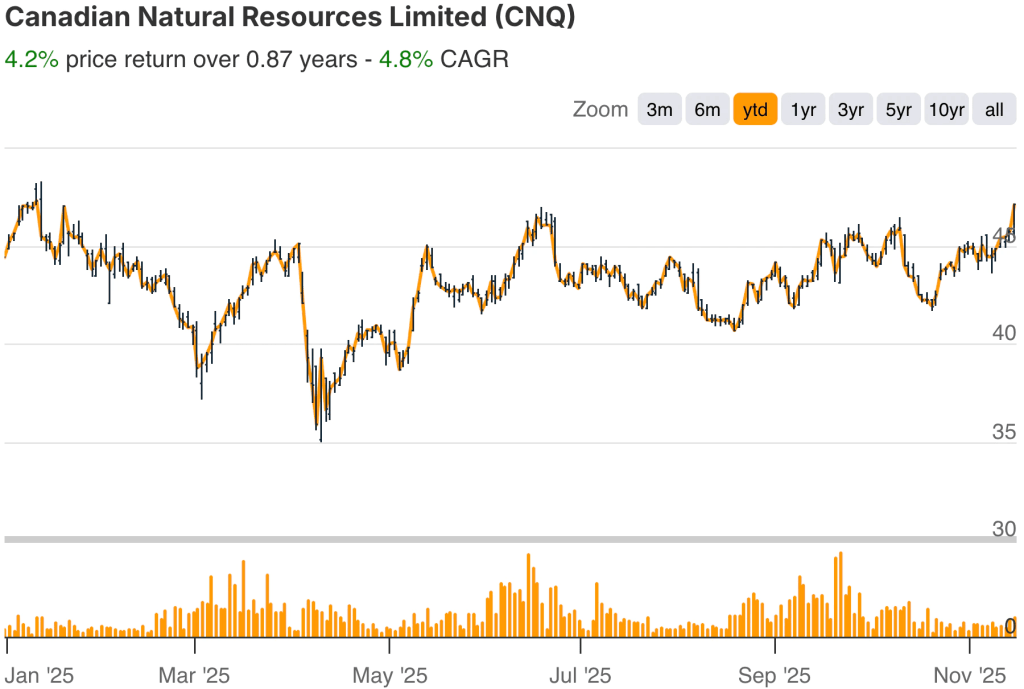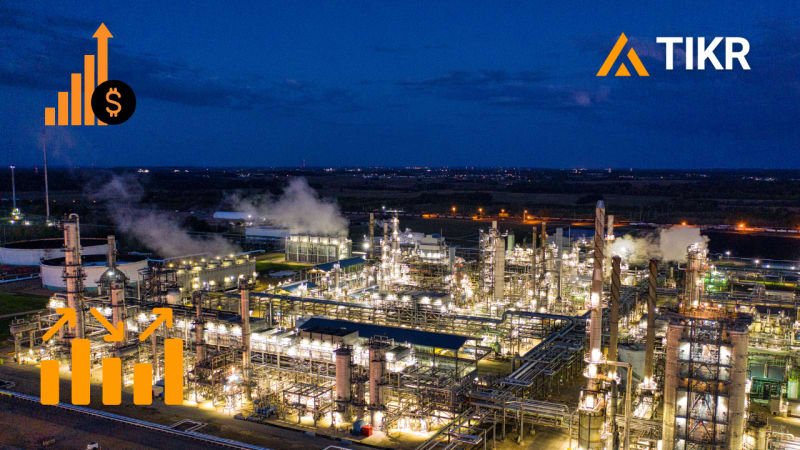Canadian Natural Resources (CNQ) is one of the most reliable long-term operators in the energy sector. The company benefits from a balanced mix of oil sands, thermal, conventional oil, and natural gas production that helps smooth out the volatility that often defines the commodity cycle. CNQ is known for operating one of the lowest-cost structures among major North American producers. That advantage gives it room to generate healthy cash flow even when energy prices shift from quarter to quarter.
Discover how much upside your favorite stocks could have using TIKR’s new Valuation Model (It’s free) >>>
This past year showed how that model works in practice. Crude prices moved in a narrow band, natural gas remained weak, and global demand faced mixed signals. Even so, CNQ continued to produce strong earnings and steady cash flow. The company kept capital spending disciplined and returned a meaningful amount of cash to shareholders. The combination of stable production, low operating costs, and a strong balance sheet helped CNQ remain resilient as other producers faced greater pressure.

Looking ahead to 2026, the environment appears steadier. Supply and demand appear more balanced, and global inventories continue tightening. CNQ enters this period with consistent production, rising free cash flow, and a clear focus on shareholder returns. Investors often gravitate to CNQ during periods of uncertainty because the business is structured to operate well across a wide range of commodity prices. The outlook for 2026 rests on that same foundation of stability and discipline.
Quickly value any stock with TIKR’s powerful new Valuation Model (It’s free!) >>>
Financial Story
CNQ delivered a modest 4.2 percent price return year-to-date in 2025, translating into an annualized gain of 4.8 percent. The stock did not capture the same momentum as other Canadian sectors this year, but the company continued to deliver strong financial results beneath the surface. Q3 2025 marked another quarter of rising earnings and growing cash flow, as net earnings reached $ 1.96 billion, up 14% from last year. Adjusted net earnings rose as well, helped by stable production and better realized pricing.
| Metric | Q3 2025 | YoY Change | Sequential (vs Q2 2025) |
|---|---|---|---|
| Net Earnings | 1.96B | +14% | Higher |
| Adjusted Net Earnings | 2.03B | +11% | Higher |
| Adjusted Funds Flow (AFF) | 3.36B | +9% | Higher |
| Cash Flow From Operations | 3.12B | +8% | Higher |
| Net Earnings per Share | 1.75 | +13% | Higher |
| Adjusted EPS | 1.82 | +10% | Higher |
| Operating Cash Flow per Share | 2.75 | +7% | Higher |
| Net Capital Expenditures | ~1.15B | Flat | Slightly higher |
| Free Cash Flow | ~2.0B | Higher | Higher |
Cash flow remained one of the clearest strengths. Adjusted funds flow increased by 9% year over year to reach $ 3.36 billion. Cash flow from operations also improved across the quarter. Per-share performance followed the same pattern, with adjusted EPS growing 10% year over year. These improvements came with steady capital spending. Net capital expenditures were roughly flat, helping CNQ deliver about $2 billion in free cash flow. That growth in free cash flow puts the company in a stronger position heading into 2026.
Look up Canadian Natural Resources full financial results & estimates (It’s free) >>>
Broader Market Context
Energy markets remained uneven across 2025. Crude prices traded in a tight range for much of the year, while natural gas continued to feel pressure from high storage levels and mild weather. Producers that rely heavily on gas faced more volatility. CNQ was able to offset some of that weakness through its diversified production mix, which includes heavy oil, light oil, natural gas liquids, and synthetic crude. This mix gives CNQ more flexibility than companies tied to a single commodity.
The broader industry also saw rising attention on capital discipline. Investors want companies to avoid heavy spending cycles and focus on returning cash. CNQ remains one of the clearest examples of that approach. The company kept costs under control, prioritized strong free cash flow, and continued its multi-year pattern of dividends and repurchases. This steady capital discipline has become a key part of the story for investors who value predictability in a volatile sector.
1. Production Stability Supports Consistent Cash Flow
CNQ’s production profile creates an essential sense of stability. The company operates a long-life oil sands base that produces predictable volumes with limited decline rates. This foundation helps offset the natural decline from conventional assets. Across Q3, production remained steady, allowing the company to convert strong commodity prices into meaningful free cash flow. The mix between heavy oil, synthetic crude, and liquids supports a healthier revenue profile during periods when gas prices remain soft.
Heading into 2026, CNQ’s long-life assets help shape a clearer outlook. The company does not need aggressive drilling programs to maintain current levels. That means lower capital intensity and more available cash for dividends and buybacks. For investors, this stability is a central part of the long-term value of CNQ. It gives the company flexibility to adjust spending based on market conditions while maintaining a healthy cash flow.
2. Cost Discipline Continues to Define the Business
CNQ’s low-cost structure remains a competitive advantage. Operating costs per barrel remain at the lower end of the industry. This cost profile makes CNQ less sensitive to short-term volatility in commodity prices. The company can generate positive cash flow even when prices stay range-bound. In Q3, cost control played a significant role in raising adjusted earnings and maintaining strong per-share results.
Looking to 2026, cost discipline remains critical. CNQ has a long track record of managing expenses, even as it invests in maintenance and optimization projects across its oil sands assets. This long-term focus on efficiency helps the company maintain margin strength. Investors often see CNQ as a safer way to gain energy exposure because the business avoids the sharp swings seen in higher-cost producers.
Value stocks like Canadian Natural Resources in less than 60 seconds with TIKR (It’s free) >>>
3. Shareholder Returns Strength the Long-Term Case
Shareholder returns remain one of CNQ’s biggest attractions. The company continued returning cash through both dividends and buybacks in Q3. Free cash flow reached nearly $2 billion, which helped support these capital returns. CNQ follows a clear framework that directs excess cash toward shareholders once capital spending and balance sheet targets are met. This approach has built trust among investors who value transparency in capital allocation.
Heading into 2026, CNQ appears positioned to continue this pattern as free cash flow should remain strong if commodity prices hold near current levels. Even in a softer price environment, the company maintains enough financial flexibility to support its dividend and maintain a measured level of repurchases. This consistent return of capital separates CNQ from producers that swing between high payouts and sudden cuts.
The TIKR Takeaway

TIKR makes CNQ’s long-term strengths easy to see, and multi-year financials show a company that maintains steady production, keeps operating costs low, and produces strong free cash flow across different commodity cycles. When you view the company’s earnings, cash flow, and per-share trends in TIKR, the pattern becomes clear. CNQ is built for resilience, not rapid shifts. For investors who want stable exposure to the energy sector, TIKR highlights why CNQ remains a long-term anchor in many portfolios.
Should You Buy, Sell, or Hold Canadian Natural Resources Stock in 2025?
The stock’s modest performance in 2025 leaves room for improvement if commodity prices stabilize or rise. Strong cash flow, disciplined spending, and consistent capital returns support a solid long-term outlook. CNQ may not deliver rapid growth, but it continues to produce reliable results that appeal to long-term investors.
How Much Upside Does Canadian Natural Resources Stock Have From Here?
With TIKR’s new Valuation Model tool, you can estimate a stock’s potential share price in under a minute.
All it takes is three simple inputs:
- Revenue Growth
- Operating Margins
- Exit P/E Multiple
If you’re not sure what to enter, TIKR automatically fills in each input using analysts’ consensus estimates, giving you a quick, reliable starting point.
From there, TIKR calculates the potential share price and total returns under Bull, Base, and Bear scenarios so you can quickly see whether a stock looks undervalued or overvalued.
See a stock’s true value in under 60 seconds (Free with TIKR) >>>
Looking for New Opportunities?
- See what stocks billionaire investors are buying so you can follow the smart money.
- Analyze stocks in as little as 5 minutes with TIKR’s all-in-one, easy-to-use platform.
- The more rocks you overturn… the more opportunities you’ll uncover. Search 100K+ global stocks, global top investor holdings, and more with TIKR.
Disclaimer:
Please note that the articles on TIKR are not intended to serve as investment or financial advice from TIKR or our content team, nor are they recommendations to buy or sell any stocks. We create our content based on TIKR Terminal’s investment data and analysts’ estimates. Our analysis might not include recent company news or important updates. TIKR has no position in any stocks mentioned. Thank you for reading, and happy investing!








